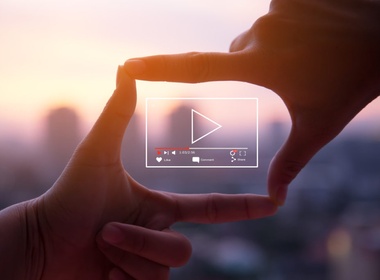YouTube SEO: How to Optimize Your Videos to Rank
Because people take to YouTube for a lot more than just quick bursts of entertainment, video content creation and optimization need to be looked at seriously. With over 20 billion visits a month, YouTube is the second most popular website viewed worldwide. For a growing brand, that is a potential monthly audience roughly the size of Facebook .
Learning YouTube SEO is a critical component for engaging with that massive viewer base. As a platform that provides entertainment and education, YouTube attracts a healthy variety of users who come together as a highly active and involved community. For anyone wanting to create content, build a loyal following and boost organic traffic, understanding how to optimize YouTube videos can't be overlooked. Here is everything you need to know about YouTube SEO, including tips on how to rank YouTube videos and optimize your content.
What is YouTube SEO?
With more than 500 hours of video uploaded onto YouTube every minute, reaching and engaging the right viewers can seem daunting. Fortunately, there are SEO recommendations that can help focus marketing efforts, enhance brand awareness and drive traffic. As is the case with any quality optimization practice, the object of YouTube SEO is to strategically improve video rankingsRankings
Rankings in SEO refers to a website’s position in the search engine results page.
Learn more so your content can reach its intended audience. The end goal is to connect with a new demographic of viewers who want to continue seeing your content by subscribing to your channel and visiting your websiteWebsite
A website is a collection of HTML documents that can be called up as individual webpages via one URL on the web with a client such as a browser.
Learn more.
It's important to remember that, like any search engineSearch Engine
A search engine is a website through which users can search internet content.
Learn more, YouTube uses an algorithm to rank SERP listings that attempt to connect users with the most relevant and useful videos. Also, just because Google owns YouTube, the same SEO practices that help a website rank may not work for a video. With that being said, there is overlap. Keep in mind that when someone searches for a video in Google, what displays in the SERP will be based on YouTube SEO. That means that not only does your video optimization help you rank outside of YouTube, but when someone then watches your video on the platform, it registers as a click-through, translating to all-around site ranking and added organic traffic. So while there are some basic commonalities between types of SEO practices, having a specific and separate YouTube SEO guide is key.
YouTube SEO Tips
Good YouTube SEO starts at the point of content creation. To have videos that rank, you need to have a plan. Because the driving force of YouTube is entertainment and education (as opposed to selling a product), video content needs to always provide engaging and self-generated value. In other words, a video needs to stand alone, captivating and informing people who may not be familiar with your brand. Most importantly, making videos that people want to watch will help your YouTube SERP rankings and place your video on the list of recommended views. As you begin creating more SEO-conscious content, use these YouTube SEO tips to get ahead:
- Video Type - This can be applied in many ways, but the most critical question is the topic of the video and how it should be made. Choosing the topic of your video means doing some research. See what else is already out there relating to the content you want to create and consider what will make yours unique. The more tailored and useful your video is, the more people will watch it. In terms of how you will make it, think back to education and entertainment. A video that relies heavily on relaying information may be best designed as a How-To video, the most popular type of content on YouTube . If the goal is brand awareness, you may choose a more marketing-driven approach, making captivating videos that pique viewer interest. Or, and even better, you will do a bit of both!
- Length - This was once a debated topic, but the consensus seems to be that shorter is not necessarily better. The truth is, YouTube actually prefers longer videos (or at least longer videos that people watch all the way through). Now, that doesn't mean that videos should be intentionally slow and drawn out—keeping viewers interested with quality content will always be paramount. However, a longer video does encourage people to spend more time on the platform, whereas shorter videos make a more fragmented user experienceUser Experience
User experience (or UX for short) is a term used to describe the experience a user has with a product.
Learn more, leading to discontinued use. - Watch Time - Here is where quality content comes into play. Watch time is essentially how much of a given video someone watches, and by tracking it, YouTube is fighting back against thumbnail clickbait. Make sure your video is relevant and accurate so that people who choose to watch it will watch it until the end. Don't front-load all your key information. Instead, spread out the value of your video. That way, viewers will be encouraged to watch it all the way through to get everything out of it.
- Accessibility - This is a simple one, but you want to do everything you can to add value and utility to your videos, keeping them high in YouTube's algorithm rankings. This can be as simple as adding an SRT file for subtitles and closed captions that help people who have hearing impairments or can't watch with the sound on.
- YouTube Tags - The tags are search marketing opportunities for your videos. They are words or phrases that explain what your video is about to the YouTube search engine algorithm so it can show the video to relevant searchers, functioning similarly to hashtags on Twitter or Instagram. They provide important context to the videos you post and can increase the likelihood that YouTube will show your video to search and categorize it correctly.
How to Boost Youtube SEO
Once your video is made, it's time to apply SEO strategies. You can think of your YouTube video SEO as a cycle that will raise your rankings. The more creatively useful your video is, the more people will watch it (and watch it until the end). The higher your watch time and engagement, the better it will rank in the algorithm, allowing it to be seen by more people. The trick is getting those initial views. Follow these 5 YouTube SEO tips to get you there.
Keyword Research
One of the things that all SEO has in common is strategic keywordKeyword
A keyword is what users write into a search engine when they want to find something specific.
Learn more usage, and as always, that begins with research. For YouTube SEO, keywords will most often be placed in the title and description, so finding popularly searched words is just as important as ones that accurately describe your video content.
Identify top keywords based on the topics addressed in your video. You can broaden your search and find more relevant keywords using tools such as:
- YouTube’s autocomplete feature
- Conductor's Result Types, to identify which tracked search queries appear in search results
- Conductor's YouTube Video Performance, to identify the top referring keywords on YouTube
- Explorer, to identify relevant queries appearing with video results in a Google SERP and determine whether a given domain owns those video results
Video Title and Video File
Creating a catchy and keyword-focused video title is important for all the obvious reasons. What can often be overlooked is the video file title. The YouTube algorithm will see your file title and use it to help determine your video's relevance.
To optimize YouTube videos, craft a title that satisfies all the following criteria:
- Contains your target keyword or keywords
- Reflects your video’s content
- Compels users to click through by asking yourself, “If I didn’t know this company, would I want to click on this?”
- Keeps titles shorter than 70 characters
Description
Video description success comes down to being informative, creative and accurate. You want to write a description that makes your video stand out with both authority and quality. You also want it to accurately portray the style and content of your video. This balance encourages views and enhances watch time.
- The more illustrative the description, the better. Remember, YouTube’s limit is 5,000 characters.
- Include your primary keyword and incorporate related keywords, but don’t keyword stuff—only mention or add keywords where necessary and relevant.
- Consider how the description appears to users as you format it.
- Use the blue and green areas of the description:
- Blue (above the fold):
- Write a brief description of your video, keeping in mind the above YouTube SEO keyword tips. Be sure to use a primary keyword in this area and expand on what the viewer should expect to see and learn from this video. Accuracy is key.
- Green (below the fold):
- YouTube says that there are “infinite ways” to organize and use this space, so be creative.
- Include a call to action for the viewers. That can mean asking for comments, click-throughs to a specific URLURL
The term URL is an acronym for the designation "Uniform Resource Locator".
Learn more or participation in a special campaign. - Add links to at least two other videos. These can be related videos or simply your most recent uploads.
- Always include the following “signature” (as relevant):
- Find us at: [Your organization’s website URL]
- Follow us on LinkedIn: [Your organization’s LinkedIn URL]
- Follow us on Twitter: [Your organization’s Twitter URL]
- Like us on Facebook: [Your organization’s Facebook URL]
- Follow us on Instagram: [Your organization’s Instagram URL]
Thumbnail
The thumbnail you choose for your video should be both eye-catching and faithfully represent the video's content. Here is another place where imagining user experience is helpful. You want something that will stand out in a long list of videos, and at the same time, previews what a viewer can expect once they begin watching. As with titles, ask yourself whether this thumbnail compels you to click, and once you do, does it deliver the content you expected?
- Thumbnails must reflect the title of the video.
- Use high-resolution images to avoid blurriness.
- Source your thumbnail image directly from video content.
- You can edit this image by adding filters or changing colors.
- Use dimensions 1280 x 720 pixels for best results.
Cards and End Screens
One of the most important aspects of YouTube is its ability to perpetuate continued usage. Most commonly, people will experience this when a video they are watching ends, and a recommended and relevant video begins automatically. But this concept can also carry over to click rates. Instead of just relying on YouTube's "next" video recommendation to keep viewers interested, you can use cards and end screens to engage them further. These are links built into the video that allow users to make more meaningful connections with your brand by offering additional content. In addition, they can help direct satisfied viewers to more of your YouTube videos, your website or any other pagePage
See Websites
Learn more or platform.
Use the “1 Video | 1 Subscribe | 1 Link” template:
- Set the Video button as “Best for viewer” as this allows YouTube to suggest a related video automatically, rather than requiring you to select one manually.
- The Subscribe button is set automatically.
- Set the Link button to a website, a specific product page or blog post or another relevant location pertaining to the video.
Channels and Playlists
When it comes to continued usage, channels and playlists are key players. This starts by simply making a channel where your content can live in an organized and accessible way. If viewers are interested in seeing more of your video content, your channel will be the first place they look. While people can directly search for your channel to find all your video content, having all your individual videos optimized to rank is the best way to get them there organically. This is particularly true if you have a wide array of content. If someone finds just one of your videos and clicks through to your channel, all of your content opens up to them. So, dedicating time to optimize each of your videos is essentially doing SEO work for your YouTube channel. It's also beneficial to categorize your videos into playlists that enhance a viewer experience by leading people through a series of videos that work together to deliver comprehensive information.
Click Play On Your YouTube SEO
It's no longer enough to rely on blog posts to deliver detailed and informative answers to curious online users. Having a multi-media balance between articles, podcasts, infographics and videos, is necessary to best reach your audience with quality and accessible content. When it comes to creating and sharing videos, knowing how to optimize YouTube content will ensure that your brand makes the most of every tool available. Get started today with our on-demand webinar Optimizing Video Content on YouTube to ensure your videos are reaching your target audience.







